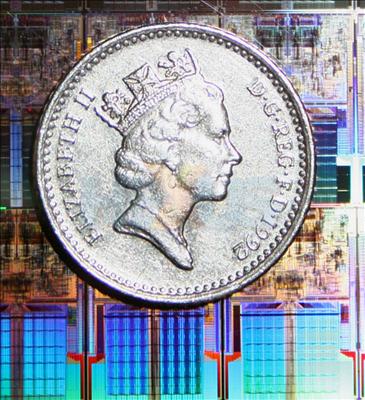Competitive comparison and some nude shots
Let's contextualise it with ye olde table.
| Processor name | Intel Core 2 Extreme QX9650 | Intel Core 2 Extreme QX6850 | Intel Core 2 Duo E6850 | AMD Athlon 64 X2 6400+ | AMD Athlon 64 X2 6000+ |
|---|---|---|---|---|---|
| Form factor | LGA775 | LGA775 | LGA775 | AM2 | AM2 |
| Manufacturing process | 45nm | 65nm | 65nm | 90nm | 90nm |
| Die size | 214mm² (2 x 107mm) | 286mm² (2 x 143mm) | 143mm² | 219mm² | 219mm² |
| Transistors | 840m | 582m | 291m | 243m | 243m |
| Physical cores | 4 | 4 | 2 | 2 | 2 |
| Inst. per clock | 4 | 4 | 4 | 3 | 3 |
| Pipeline stages | 14 | 14 | 14 | 12 | 12 |
| Clock speed | 3.0GHz | 3.0GHz | 3.0GHz | 3.2GHz | 3.0GHz |
| FSB | 333MHz (1333MHz QDR) | 333MHz (1333MHz QDR) | 333MHz (1333MHz QDR) | 200MHz | 200MHz |
| Memory support | DDR2/3, 800MHz/1066MHz, DC | DDR2/3, 800MHz/1066MHz, DC | DDR2/3, 800MHz/1066MHz, DC | DDR2, 800MHz, DC | DDR2, 800MHz, DC |
| L1 cache total | 128KiB data + 128KiB code | 128KiB data + 128KiB code | 64KiB data + 64KiB code | 128KiB data + 128KiB code | 128KiB data + 128KiB code |
| L2 cache total | 12MiB | 8MiB | 4MiB | 2MiB | 2MiB |
| ISA | x86, x86-64, SSE-SSSE4.1 | x86, x86-64, SSE-SSSE3 | x86, x86-64, SSE-SSSE3 | x86, x86-64, SSE-SSE3 | x86, x86-64, SSE-SSE3 |
| TDP | 130W | 130W | 65W | 125W | 125W |
| Operating voltage | 1.1-1.2V | 1.2-1.3625V | 0.965-1.35V | 1.3-1.35V | 1.3-1.35V |
| Current price | £600 | £600 (phased out) | £165 | £129 | £99 |
Take a look at the QX9650 and QX6850's vital statistics for a moment. Despite ballooning the 45nm Yorkfield's transistor count up to around 840m, representing a 44 per cent increase over a 65nm Kentsfield-based processor, and made up through the implementation of an extra 50 per cent L2 cache, we see that the die size is actually 25 per cent smaller. These apparently contradictory figures do make sense once you consider that the 45nm manufacturing process can fit in twice as many transistors in to a given space when compared to 65nm.
Looking across the chart we see that AMD's soon-to-be-replaced K8 architecture is headlined by two dual-core processors whose transistor count is 'only' 243m but, being based on a comparatively large 90nm process, their die-space requirements are a little larger than Intel's quad-core Yorkfield's. Of course, one company's method of counting transistor doesn't always align with the competition's, so take these stats with a healthy pinch of salt. Nevertheless, a smaller manufacturing process is good. Marrying up with the 45nm process is a reduction in operating voltage.
We duly note that AMD's on-die memory controller makes a lot more implicit sense than Intel's front-side bus approach, especially with four cores concurrently thrashing memory access. The short-term fix, which we'll probably see with the introduction of Intel's upcoming X48 chipset, should be manifested in a 1600MHz FSB for the Extreme Yorkfield model, offering up more bandwidth and relieving, to some extent, the inadequacy of the shared-FSB architecture.
The real competition from AMD will be posed with the introduction of the Phenom X4 processor, based on the Barcelona core and due out, well, quite soon. It would be remiss of us to conjecture upon its potential performance without any hard-and-fast data, and we wait with bated breath for the QX9650 vs. Phenom X4 showdown.
In the buff
Yup, it's an engineering-sample processor. LGA775 form factor and it should slot right in to any motherboard released in the last three months, albeit with a BIOS update. The range-topping model also features an unlocked multiplier, offering enthusiasts a wide range of FSB selections for ultimate tweaking.
We're not allowed to deface an image of our sweet and gracious queen, so we've plonked on a quid atop of a 45nm wafer of Penryn processors. Vandalising Intel property is so much more fun!

Yorkfield at 3.0GHz. How soon before a 3.2GHz-clocked model with a 1600MHz FSB, sat atop of an Intel X48 motherboard?












